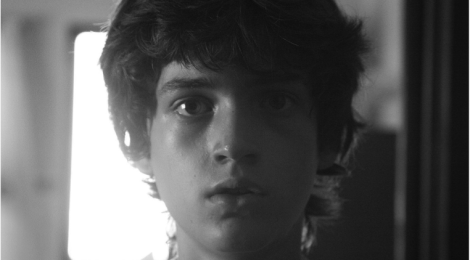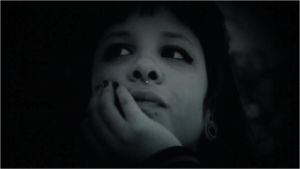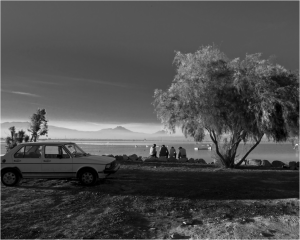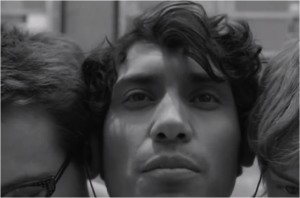
Güeros (Alonso Ruizpalacios, Mexico, 2014)
Olivia Cosentino is a MA/PhD Student in Latin American Literatures and Cultures in the Spanish and Portuguese Department at the Ohio State University, where she is also studying for an MA in Film and Media Studies. Her research interests include youth and gender studies in post-epoca de oro Mexican cinema.
Güeros is an incredible debut by director Alonso Ruizpalacios. The film has received considerable hype both at home and abroad, winning 5 Mexican Ariel Awards several weeks ago (including Best Picture, Best Director and Best Cinematography) and earning over 12 prizes on the festival circuit in 2014, notably Best First Feature from the Berlin International Film Festival and Best Cinematography from the Tribeca Film Festival. A quick plot summary: Tomás (Sebastián Aguirre) is sent by his mother to spend a month in Mexico City with his brother, Federico (Tenoch Huerta), nicknamed Sombra. He and his roommate, Santos (Leonardo Ortizgris), fill their days with card tricks, cutting out people from the newspaper to add to their fridge collage and feeble attempts to work on their theses as the 1999 student strike at the UNAM (National Autonomous University of Mexico) continues. The two oblige Tomás’ wishes to pay his last respects to rock legend, Epigmenio Cruz (Alfonso Charpener), who is reportedly dying in a hospital. Their search for Cruz takes the boys to all corners of the capital, including the UNAM where they pick up Sombra’s love interest, the student revolutionary leader Ana (Ilse Salas).
Ruizpalacios’ film falls into a greater trajectory, or should I say inundation, of contemporary Mexican films whose narratives center upon youthful protagonists. The list is endless, but I make the obligatory mention of the critically acclaimed Y tu mamá también (Alfonso Cuarón, 2001), (central to the Mexican film industry’s critical revival), as well as Mil nubes de paz cercan el cielo, amor, jamás acabarás de ser amor (Julián Hernández, 2003), Temporada de patos (Fernando Eimbcke, 2004), Lake Tahoe (Fernando Embicke, 2008) and Voy a explotar (Gerardo Naranjo, 2009), all of which share either aesthetic and/or thematic similarities to Güeros.
Güeros is intensely sensorial, like the work of Hernández and Eimbcke, and delights in cinematographic extremes. Ruizpalacios favors close-ups of facial expressions (a technique that is notably also crucial to the aesthetics of Argentine filmmaker Raúl Perrone’s 2013 black and white youth skater film, P3ND3JO5) and extreme long takes and long shots of landscape filmed with a static camera which allow the audiences’ eyes to wander and wonder.
P3ND3JO5 (Raúl Perrone 2013)
Güeros
Lake Tahoe (Fernando Eimbcke 2008)
The visual extremes echo the emotional highs and lows that Mexican youth, especially those in crisis, face on a daily basis. Güeros ambitiously represents Sombra’s recurring panic attacks; Ruizpalacios emphasizes Sombra’s labored breathing that overtakes the soundtrack as he drags endlessly on a cigarette. Later, a blinding white light turns into a high pitched vibration as Sombra sees feathers raining from the sky. It is terrifying yet tantalizing to the senses, and clearly torturous for Sombra who believes he is going crazy.
Thematically, Güeros underscores the confusing mixture of emotions (melancholy, stress, freedom and joy) that coming-of-age brings. As they are stopped in the inevitable DF traffic on the highway, Ana asks, “Would anyone know if we died?” In response, Sombra turns off the engine and the two revel in their rebellion despite the unbearable din of honking that quickly follows (confirming that if they had died, other cars would take notice of the inconvenience). It is important to note that in all of the youth films mentioned above, parents are rarely seen and play cursory roles at best. Youthful crisis is perhaps predicated by the lack of parental involvement and the collapse of the nuclear family, leaving youth to navigate the world with only their friends, lovers or siblings at their side.
Reviews of Güeros are quick to mention French New Wave influences (because every film wants to pay homage to the French, right?). The French New Wave movement was the first to consider youth as a subject matter and to take it seriously – demonstrated by the canonical The 400 Blows (Francois Truffaut, 1959) or Breathless (Jean-Luc Godard, 1960) – and furthermore, popularized strategies like filming on location in city streets, long takes and using non-professional actors as ways of coping with a small budget. Güeros is filmed almost exclusively without sets – the exception being Sombra and Santos’ flat – and underscores the diverse urban geography of the capital city. Güeros quickly becomes a project in cinematographic cartography as the film subdivides by location – Sur (South), Poniente (West), Ciudad Universitaria (University City), Centro (Center), Oriente (East) – following the protagonists on their “road trip” within Mexico City. The protagonists and audience are exposed to the ins and outs of chilango life – a pulquería, a snobby film premiere party, the empty fish market, the UNAM, a public hospital, a vegetable farm and the Chapultepec Zoo. New Wave directors were also notorious for irony and sarcasm, which is certainly present in Güeros. At the film premiere where the characters rub elbows with all the beautiful people of Mexico City, Sombra rants about the “puto cine mexicano” [effing Mexican cinema] and scoffs, saying that anyone who films in black and white thinks that they are really making cinema (Ruizpalacios gives the audience a wink-wink).
The title of the movie itself is consciously tongue-in-cheek. Güeros opens with a definition of “güero” as 1) “De cabellos rubios” [Blonde-haired] and 2) “De cutis claro” [Light-skinned]. As the film is in black and white, it is not immediately obvious who is blonde, but this suggests that the term güero refers to more than just complexion or hair color. I take this to be an implicit commentary on the racial politics in Mexico which bind race with social class. Santos takes offense at being called a güero by the security guard at the ritzy party and demands to know who looks like a güero, grabbing Sombra and yelling, “Does this look like a güero to you?” Both Santos and Ana joke with Sombra, separately asking him why he turned out so prieto [swarthy, dark-skinned] when his brother is such a güerito. We also finally realize that Epigmenio’s album is called Los Güeros, but the opportunity to problematize the racialized term is not lost on the film.
Why has this film been successful? Put simply, Güeros is smart. Incredible sound design, a well-written script with laugh out loud funny moments (for both me and the Mexicans in the audience), beautiful cinematography that dazzles, impeccable casting and an honest representation of Mexico City that lacks the gloss that characterizes much of contemporary, neoliberal Mexican cinema aimed at pleasing (and putting blinders on) upper-middle class and foreign audiences (Sexo, pudor y lágrimas [Sex, Shame & Tears, Antonio Serrano, 1999], Cansada de besar sapos [Tired of Kissing Frogs, Jorge Colón, 2006], LuTo [Katina Medina Mora, 2013], A la mala [Pedro Pablo Ibarra, 2015]). Güeros has something to say: “Ser joven y no ser revolucionario es una contradicción” [to be young and to not be a revolutionary is a contradiction] and it is not afraid to say it, both on promotional materials as well as diegetically in scenes of the UNAM strike. I hope Güeros is an indication of the kind of quality cinema that we can expect from Ruizpalacios and other newbie Mexican filmmakers in the future.










